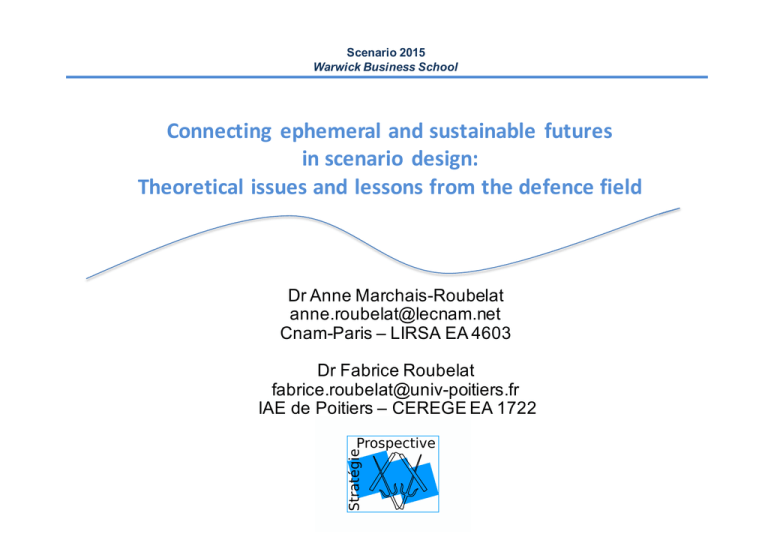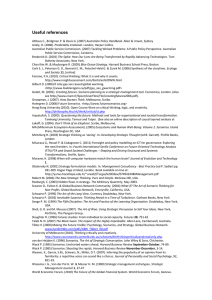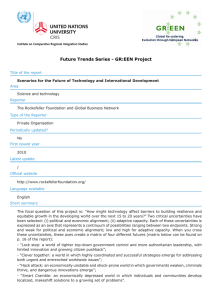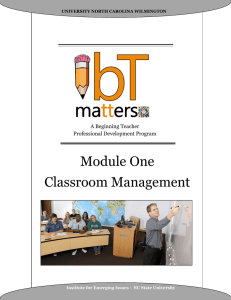Connecting ephemeral and sustainable futures in scenario design: Theoretical issues and lessons from the defence field
advertisement

Scenario 2015 Warwick Business School Connecting ephemeralandsustainable futures inscenario design: Theoreticalissuesandlessonsfromthedefencefield Dr Anne Marchais-Roubelat anne.roubelat@lecnam.net Cnam-Paris – LIRSA EA 4603 Dr Fabrice Roubelat fabrice.roubelat@univ-poitiers.fr IAE de Poitiers – CEREGE EA 1722 1. Introduction Connecting scenarios, sustainability and ephemerality Theoretical background Scenarios, foresight and… Ever moving rules (Berger, 1957, Marchais-Roubelat and Roubelat, 2015)) Pushing the boundaries of plausibility (Kahn, 1966, Sardar and Sweenay, 2016) Enhancing scenario thinking to include stakeholders in scenario design (Wright and Cairns, 2011, Cairns, Wright and Fairbrother, 2016) Introducing sustainability in futures thinking (Crivits et al., 2010, Vergragt and Quist, 2011) Probing ephemeral futures (Roubelat, Brasset, McLean, Hoffmann, Kera, 2015) A.Marchais-Roubelat- F.Roubelat Connectingephemeralandsustainablefutures 2 2.Methodological proposals Ruling scenarios: stakeholders in motion What? Why? Designing scenarios from action • ACTION RULE Framing scenarios from values • INSTUTIONAL RULE • Looking forstakeholders’acts • andunsunstainable ones • Justifying stakeholders’behavior • andwhat opposesthe action How? What’s next? Organizing scenarios in action • OPERATIONS RULE Challenging scenarios •STEERING RULE • Uncovering theconstrains ofthe action • Andwhat organizes theaction A.Marchais-Roubelat- F.Roubelat •Assessing scenariosustainability •Finding outephemeral distortions Connecting ephemeral andsustainable futures 3 3 Lessons from a case study: Defence Strategic action-based scenarios The context of the case: connecting geostrategic and operations foresight Defenceforesight types Actionprocessscope Sustainability issues Geostrategicforesight Anticipating geopolitical changes, newcrisesand threats Sustainability of newtechnological powersandstakeholders,sustainability ofthecontinuumbetweensecurityand militarytechnologies, durationofnew technologicalthreats(biotechnology, informationtechnology…) Operationsforesight Sustainability of newtechnologies (remotecontrolweapons,cyber warfare,humanaugmentation…), diffusionoftechnologies among defenceandsecurityactors,militaryuse ofnon-militarytechnologies Anticipatingnew strategicand operationstheatres 3. Results. Lessons from the Defence field. Questioning « shattered bricks » scenario On the sustainability of stakeholders’ acts Rule Stakeholders’movements Sustainability/ ephemerality issues Actionrule Successively combatingseveral militarypowers usingarmedforce Whatstakeholdersareactingon Regularwarbetweencoalitionsorganised aroundshatteredBRICcountries Whatstakeholdersarenotactingon– Unsunstainable acts Avoidingstrikes(ephemeralacts)oneconomic capacitiesandinfrastructures,nuclearfacilities, naturalareasandagriculturalland Levelofusebymost ofshatteredBRICS ofnuclearand technological capabilities(namely drones,combat robots,satellites, cybertechnologies) Institutionalrule Designatingone orseveral enemiesin responseto militaryactions Whatopposestheaction ShatteredBRICsuseconventionalcapabilities,as wellasnucleardetterrence Whatjustifiestheaction OneoftheshatterednationsfromtheBRICs requeststheassistanceagainstoneorseveralof itsneighbours Economicand environmental consequencesofthe useofnuclearand conventional weapons A.Marchais-Roubelat- F.Roubelat Connectingephemeralandsustainablefutures 5 3. Results. Lessons from the Defence field Managing in time stakeholders’ capabilities Rule Stakeholders’movements Sustainability/ ephemerality issues Operationsrule Managingthe variabilityofthe allianceson scatteredtheatres Constraints: Varyingconflictscalesdependingonthe belligerentnationsonvariabletheatres Intermittentcombatsoverseveralyears Highintensitycombatswith substantial losses, bothhumanandmaterial Organization: Regenerationbynewalliances,reorganization orbymomentarilyexitingtheconflict Regenerationof capabilities Ephemeral exitof theconflicts A.Marchais-Roubelat- F.Roubelat Connectingephemeralandsustainablefutures 6 3. Results. Lessons from the Defence field Towards a moving end-state Rule Stakeholders’movements Steering rule Transfer: reconstitution of a BRIC, extension of the conflict, durable defeat in one of the theatres, refusal to designate the enemy Designing changing military end states Sustainability/ ephemerality issues Unsunstainable stakeholder behavior Long-duration use of Stalemate: the scenarios lasts from several capabilities years: constant combat Oscillation: The conflicts cease for several years then start again with the same actors: successive combat becomes alternative combat Phase lag: increased variability of the alliances or incapacity to disengage theatres in time either through a lack of capacities or because the enemy's capacities have been strengthened A.Marchais-Roubelat- F.Roubelat Short-term regeneration of capabilities Unaccepted decrease of capabilities by some stakeholders Connectingephemeralandsustainablefutures 7 4. Discussion. Epistemological and methodological consequences Tracking sustainability, uncovering ephemerality Designing iterative sustainable scenarios Challenging paradigm shifts and paradigm dead-ends Navigating across scenarios Futurizing parallel scenarios Designing pop-up scenarios Acting unacceptable and unlikely acts, behaviors or constraints Playing with gaps, rhythms, paces beyond scenario plausibility Questioning scenario sustainability and ephemerality Designing scenarios from action: crisis management scenarios, emergency scenarios, strategic action scenarios Designing experience scenarios from stakeholders’ acts: user scenarios, normative scenarios A.Marchais-Roubelat- F.Roubelat Connectingephemeralandsustainablefutures 8 5. Conclusion and further research A fine moving disregard …Ariadne’s thread beyond sustainable endstates Thinking sustainability and ephemerality in moving scenarios Designing iterative sustainable and ephemeral scenarios Experiencing ephemeral stakeholders’ transformations Exploring interstitial spaces and actions Assessing ephemeral dominance in scenario design A.Marchais-Roubelat- F.Roubelat Connectingephemeralandsustainablefutures 9 6. References Selected references CairnsG.,WrightG.,Fairbrother P.(2016),“Promotingarticulatedactionfromdiverse stakeholdersinresponsetopublicpolicyscenarios:Acaseanalysisoftheuseof‘scenario improvisation’method”,TechnologicalForecastingandSocialChange,vol.103,p.97-108. Crivits M.,Paredis E.,BoulangerP.-M.,Mutombo E.,Bauler T.,Lefin A.-L.(2010),Scenariosbased onsustainabilitydiscourses:Constructingalternativeconsumptionandconsumer perspectives,Futures,vol.42,p.1187-1199. KahnH.(1966),“Thealternativeworldfuturesapproach”,HudsonInstitute,Croton-on-Hudson. PartlyreprintedinP.D.Aligica,K.R.Weinstein,TheessentialHermanKahn.Indefense of thinking,LexingtonBooks,Laxham,2009,p.181-197. Marchais-RoubelatA.,Roubelat(2015),“Designingamovingstrategicforesightapproach”, Foresight,vol.17.,issue6,p.545-555. RoubelatF.,Brassett J.,McAllum M.,HoffmannJ.,Kera D.(2015),“Probingephemeralfutures: Scenariosasfashiondesign”,Futures,vol. 74,pp.27-36. Sardar Z.,Sweenay J.-A.(2016),“Thethreetomorrowsofpostnormal times”,Futures,vol.75,p. 1-13. Vergragt P.J,QuistJ.(2011),“Backcasting forsustainability:Introductiontothespecialissue”, TechnologicalForecastingandSocialChange,vol.78,p.747-755. WrightG.,G.Cairns(2011),Scenariothinking:practicalapproachestothefutures,Palgrave Macmillan,NewYork. A.Marchais-Roubelat- F.Roubelat Connectingephemeralandsustainablefutures 10





